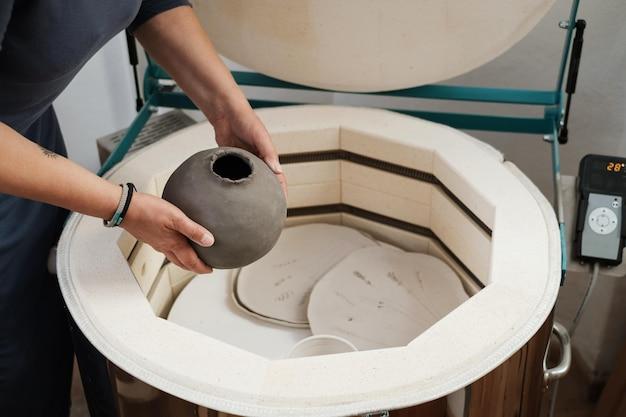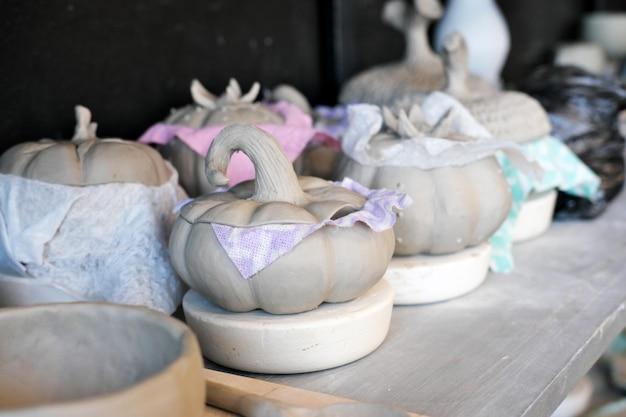Clay firing is a fundamental process in pottery and ceramics, helping transform malleable clay into solid and durable ceramic objects. But how many times does clay need to be fired? In this blog post, we’ll explore the various factors that determine the number of firings required for different clay projects.
From understanding the two stages of fired clay to learning about the shrinkage that occurs during firing, we’ll delve into the intricacies of the firing process. We’ll also address common questions like whether clay can be fired in a regular oven or with a blowtorch, and if it’s possible to make pottery without a kiln.
So, if you’re curious about the firing process and the optimal number of firings for your clay creations, keep reading! We’ll provide all the insights you need to create stunning pottery and ceramics.
How Many Times Does Clay Need To Be Fired
Firing clay is like going to the gym; it may take some discipline, but the results are worth it! So, the burning question is, how many times does clay need to be fired? Well, my curious clay enthusiasts, grab your pottery tools and let’s dive into the kiln of knowledge together!
Primary Firing: The First Flame Dance
The first time clay hits the kiln, it discovers a world of transformation. This magical moment is known as the bisque firing. The bisque kiln cranks up the heat to around 1832°F (1000°C), giving the clay a sturdy foundation. Think of it as clay’s version of hot yoga, where it becomes hard, porous, and ready for the glazes that will add that extra oomph later on.
Glaze Firing: It’s Time to Shine!
After surviving the bisque fire, it’s time for the clay to bathe in the glaze glory. This enchanting experience happens during the glaze firing – a second round of kiln adventures. The temperature soars to an even hotter cone 5 or cone 6, around 2165°F (1189°C) to 2230°F (1222°C). At this temperature, the glaze on the surface transforms into a stunning glass-like finish that brings out the clay’s artistic beauty.
The Rare Encore: Special Techniques for Masterpieces
Ah, but there’s more to the clay-fired dance than just one or two rounds! Some artists love to push the boundaries and add extra pizzazz to their masterpieces. They experiment with multiple firings, each taking their creation to new heights of artistic splendor.
Raku Firing: The Excitement of the Unknown
One such pottery party is the thrilling Raku firing technique. It’s like clay’s own adrenaline adventure! With Raku, the clay is removed from the kiln at scorching temperatures of around 1800°F (982°C) and then undergoes a rapid cool down. This rapid change in temperature leads to unexpected, vibrant colors and a distinctive crackle effect that adds personality and whimsy to the final piece.
Pit Firing: Embracing the Elements
Another adventurous technique is pit firing. This primitive method puts the clay in direct contact with fire and the elements. Picture digging a hole in the ground, stacking your creations, and surrounding them with combustible materials like sawdust or newspaper. Then, you set your artistic bonfire ablaze! Heat, smoke, and the power of nature work their magic, painting unique patterns and textures onto the clay’s surface.
Conclusion: The Fire Never Truly Dies
In the world of pottery, the fire never truly dies. It’s a journey of multiple firings, each adding a new layer of beauty, depth, and character to the clay. So whether you stick to the primary bisque and glaze firings or venture into the realms of Raku or pit firing, go forth and let your imagination ignite in the kiln’s fiery embrace!
Now, my fellow clay connoisseurs, it’s time to get your hands dirty again, shape some clay, and embrace the fiery transformation of the kiln. Remember, the clay is your canvas, and the kiln is your artistic accomplice. So fire it up and let the magic unfold!
Note: The firing temperatures mentioned in this article are general guidelines. Always refer to the specific recommendations of your clay and glaze manufacturers for optimal results.
Keywords: firing clay, bisque firing, glaze firing, Raku firing, pit firing, multiple firings, pottery techniques
FAQ: How Many Times Does Clay Need to be Fired
How Many Times Do You Fire Clay
Clay generally needs to be fired twice to achieve its final form. The first firing is called the bisque firing, and the second firing is the glaze firing. Each firing serves a specific purpose in the ceramic process.
Can Clay Dry for Too Long
Yes, clay can dry for too long. If clay is allowed to dry too much before firing, it can become brittle and crack. It’s important to monitor the drying process and ensure the clay is properly hydrated before firing.
How Do You Tell if Clay has Been Fired
Fired clay has a distinct hardness and strength compared to unfired clay. You can also observe the changes in color and texture that occur during firing. Additionally, if clay has been glazed and fired, it will have a glossy finish.
What is Clay Shrinkage
Clay shrinkage refers to the reduction in size that clay undergoes during the firing process. This shrinkage is caused by the removal of water and organic materials from the clay. Understanding the shrinkage rate of a particular clay body is essential for creating properly sized ceramic pieces.
Can You Fire Clay in a Regular Oven
No, you cannot fire clay in a regular oven. Regular ovens are not capable of reaching the high temperatures required for proper firing. Instead, a kiln is used, which can reach temperatures of up to 2200°F.
What are the Two Stages of Fired Clay
The two stages of fired clay are the bisque stage and the glaze stage. During the bisque firing, clay is heated to a lower temperature to remove any remaining water and organic materials. In the glaze firing, the clay is fired again, this time at a higher temperature to melt the glaze and create a durable, glossy finish.
Can You Fire Clay with a Blowtorch
While you can use a blowtorch to achieve heat in small areas, it is not recommended for firing clay. Blowtorches do not provide the even and controlled heat distribution necessary for proper firing. It’s best to use a kiln for firing clay.
Can I Make Pottery Without a Kiln
Yes, it is possible to make pottery without a kiln. Techniques such as air drying and using microwave kilns can be employed. However, the results may vary, and the clay may not attain the same level of durability and stability as traditionally fired pottery.
Does Pottery Clay Need to be Fired
Yes, pottery clay needs to be fired to transform it from a soft, pliable material into a hard, durable ceramic. Firing also removes any water and organic matter from the clay, making it less prone to cracking or disintegrating.
Does Clay Catch Fire
Clay itself does not catch fire. However, if there are any organic materials, such as leaves or twigs, mixed in with the clay, they may burn and cause the clay to crack or deform during firing. It’s important to thoroughly remove any organic matter from the clay before firing.
Can You Apply Slip to Bone Dry Clay
Yes, you can apply slip to bone dry clay. Slip is a liquid clay mixture that acts as a glue or decorative element when applied to unfired clay. It can be used to repair cracks, add texture, or enhance the surface of bone dry clay.
How Long Can You Keep Clay Without Firing
Clay can be kept indefinitely without firing as long as it is stored in a cool, dry place. However, it’s important to periodically check the clay for any signs of mold or deterioration. Properly stored clay can last for years, allowing artists to work at their own pace.
Why Do Ceramic Artists Fire Their Pieces a Second Time
Ceramic artists fire their pieces a second time in order to apply glaze. The glaze adds color, texture, and a protective layer to the ceramic surface. The second firing enables the glaze to melt and adhere to the clay, creating a finished and durable piece of pottery.
Does Clay Have to be Fired Twice
Generally, yes, clay needs to be fired twice. The first firing, called bisque firing, prepares the clay for glazing by removing organic matter and water. The second firing, the glaze firing, melts the glaze onto the clay surface, creating a finished piece of ceramic artwork.
Why Are Ceramics Fired Twice
Ceramics are fired twice to achieve the best results. The bisque firing removes water and organic materials, making the clay stronger and more resistant to damage. The glaze firing allows the glaze to melt and bond with the clay, creating a beautiful and durable finished product.
Does Clay Shrink as it Dries When Fired
Yes, clay shrinks as it dries and is fired. This shrinkage occurs due to the removal of water and organic materials from the clay. Understanding and compensating for this shrinkage is essential for creating pieces with the desired dimensions.
What Is Clay Called Before It’s Fired
Before it’s fired, clay is called “greenware.” Greenware refers to unfired clay that has been shaped and dried but has not yet undergone the firing process. It is still susceptible to damage and should be handled with care.
Can You Fire Pottery Twice
Yes, pottery can be fired twice. The initial bisque firing prepares the clay for glazing by removing any remaining water and organic materials. The second firing, the glaze firing, melts the glaze and creates the final, finished piece of pottery.
Is There Clay That Doesn’t Need to be Fired
There are certain types of clay, such as air-dry clay or polymer clay, that do not require firing. These clays harden on their own when exposed to air or through other means, such as baking. However, these clays may not have the same strength and durability as traditionally fired ceramics.
What Does Under-Fired Glaze Look Like
Under-fired glaze can have a dull appearance and may not have achieved its intended color or texture. It may also easily chip or flake off the ceramic surface. Properly fired glaze, on the other hand, will have a glossy and durable finish that enhances the appearance of the piece.
What Is Clay Called After It Has Been Fired
After it has been fired, clay is called “ceramic.” Ceramic refers to any object made from fired clay that has become hard and durable. The firing process chemically transforms the clay, resulting in a permanent ceramic material.

